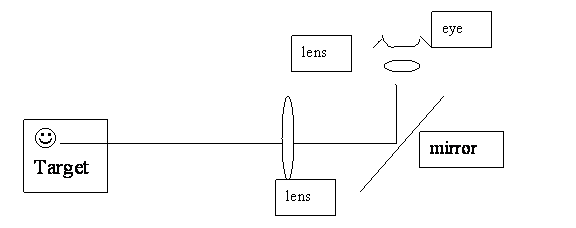
Necronomicon 2010
Hilton St. Pete
333 1st St. South
St. Petersburg, FL
Saturday, October 23, 2010
5 PM
Lecture hall St. Pete 2
M. Linton Herbert
The Steampunk Stealth Telescope
Welcome to the steampunk stealth telescope lecture. While I am speaking Jerry and Thelma and Allie will be doing some work over there, which we will turn to later. If you are driven to distraction by optics, feel free to watch them instead.
First let me introduce the conventional stealth telescope. It looks like an ordinary compact. Just a mirror. There are two other parts. One is a monocle, somewhat like the one I am holding. But they used to make monocles with a little frame in the back so you could hold it in your eye without using your hands. The other thing we will need will be an objective lens. I’ll take the one from this telescope over here. (I remove the lens from the Galilean telescope.). As you can see, it would easily fit inside a compartment in the compact.
So here I am sitting at my table on a sidewalk café spying on the bad guys, or maybe the good guys. If I used this telescope to observe them, (I demonstrate with the Galilean.) I might attract some attention. So I place the compact on the table. I took at it with the monocle, and unobtrusively I hold the objective lens in front of it. Now the light is coming from my mark, going through the objective lens, bouncing off the mirror and forming what we call a real image in space. I inspect this image with my monocle, and behold I am spying. If I have a free hand I can pinch a pimple or something to persuade people I am only interested in myself.
Here is the light path.

All right, you shouldn’t spy on people, but this is for fiction. You don’t have to use a monocle. A strong pair of reading glasses will work. So we have a stealth telescope. But it is not a steampunk stealth telescope. In order to have that, we will have to do three things. It will have to be better. It will have to be outlandish. And it will have to use goggles.
But there are things to talk about first. The telescope was invented in the Netherlands, but Galileo improved on it and was the first to use it in a study of the night sky. His discoveries were earth shaking, so to speak. Here is a sketch by him of Jupiter and her moons. It was made in January 1610.
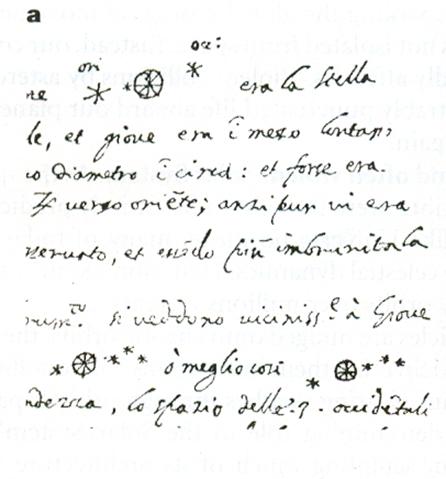
(The Four Hundred Years of Planetary Science Since Galileo and Kepler, Joseph A. Burns NATURE vol. 466 no. 7306 July 29, 2010 page 575)
It was Johannes Kepler who described the motion of the moon and particularly the planets. He, too, invented a telescope. This is a Galilean telescope, but stealth telescope is a Keplerian telescope. I will show you the difference soon.
Isaac Newton also describes the motions of the planets. His law, actually his theory, of gravity reduces mathematically to the same prediction as Kepler’s. Newton also invented a telescope. But the steampunk telescope I shall show you is not one of these three.
There have been a number of recent advances in optics. One is the field of metamaterials. What they are working on is to construct materials with a structure at and below the wavelength of light. In theory this should make it possible to build with nanotechnology telescopes and microscopes far superior to anything we have now. It may be possible to achieve invisibility with them and use them in information processing using photons at a tiny scale for greater speed than is currently available. The problem with such things so far has been the fact that most of the light gets absorbed. That has now changed with the invention of a way to amplify the light inside the material. (Loss-free and Actice Optical Negataive-Index Metamaterials, Shumin Xiao et al NATURE vol. 466 no. 7307 August 5, 2010 page 735)
The biggest limitation of ground based telescopes is air turbulence. This extends up to about 50 meters. Adaptive optical systems have been used for some time to warp the optics of a telescope and compensate for this atmospheric turbulence. This is done with analogue computers. Digital computers are just too slow for this. Well the capability of such systems has been substantially improved in the past year. (A Ground-layer Adaptive Opotics System with Multiple Laser Guide Stars, M. Hart et al NATURE vol. 466 no. 7307 August 5, 2010 page 727)
The Chinese are developing a somewhat more direct way of getting above ground turbulence. This puppy is to be built in Antarctica, which is superior in a number of ways to other places in the world.
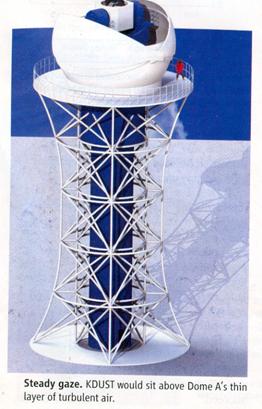
(In Ground-Based Astronomy’s Final Frontier, China Aims for New Heights, Richard Stone SCIENCE vol. 329 no. 5996 September 3, 2010 page 1136)
In looking for planets the glare from the parent star is of course an issue. You put your hand up to shade your eyes when you are looking at something close to the sun, and telescopes do the same thing. An improvement has come in the form of a “vortex coronagraph.” I do not understand this one, but it seems to work very well. (An Image of an Exoplanet Separated by Two Diffraction beamwidths from a Star, E. Serabyn et al NATURE vol. 464 no. 464 April 15, 2010 page 1018)
There is a race on to build the world’s new biggest telescope. One, being built by Jerry Nelson of Lawrence Berkeley National Laboratory in California is called the Thirty Meter telescope, to be placed on Mauna Kea in Hawaii at a cost of $1 billion and the other being built by Roger Angel of Tucson, Arizona to be called the Giant Magellan Telescope, to be placed at Las Campanas at a cost of $ 700 million. The first consists of many smaller mirrors working together and the second has a few large ones.
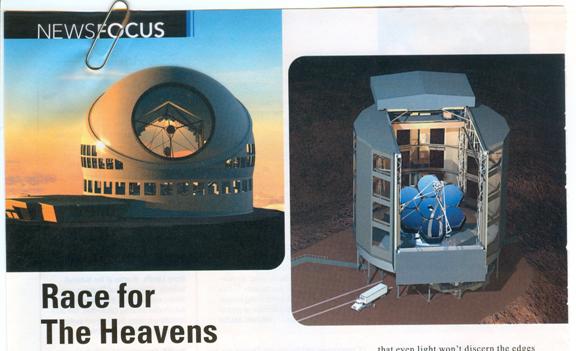
(Race for the Heavens, Yudhijit Bhattacharjee SCIENCE vol. 362 no. 5952 October 23, 2010 page 512)
And most expensive of all is the James Webb Space Telescope being built to replace the Hubble telescope. This consists of multiple mirrors which will, get this, unfold and align themselves once in space. It will have a huge parasol so it stays cold enough to do infrared work. The primary mirror has 18 beryllium segments. This is the way it is supposed to unfold.

One can only wish them luck. (Origami Observatory, Robert Irion SCIENTIFC AMERICAN vol. 303. no. 4 October 2010 page 48)
It will be placed not in earth orbit but at Lagrange 2, one of the places where the gravity of the sun, the gravity of the earth and orbital mechanics balance out so that an object can remain in place relative to the earth without much expenditure of energy. Points 1, 2 and 3 are inherently stable and require some occasional adjustment. Points 4 and 5 are more stable but are cluttered with space debris.
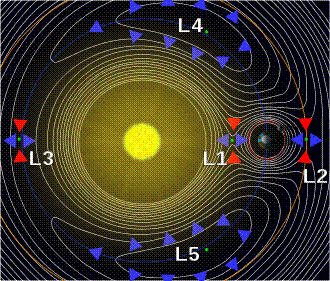
![]()
A contour plot of the effective potential of a two-body system due to gravity and inertia at one point in time.
http://en.wikipedia.org/wiki/Lagrangian_point The Wikipedia article downloaded October 3, 2010.
Now we will review a little basic optics. We will start with mirrors because I find them a little easier to understand.
If I put a pin in a cork board and take a loop of string and a pencil, I can put the string over the pin, pull it taught with the tip of the pencil and keeping it taught I can swing it around and draw a circle.
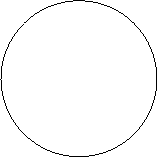
If I rotate the circle around a diameter I get a sphere. If I make a mirror shaped as the inside of a sphere I can imagine being inside it. Any ray of light that leaves the very center of the sphere will bounce right back to the center. If I stand in the sphere and look out from the center I will see an enormous eyeball looking back at me from all directions. That would be rather disturbing and quite useless.
But if I put two pins in the cork board and loop the string around both of them, keeping the line taught again, I shall draw a different shape, an ellipse.

If I rotate this around its long axis I get something called a prolate spheroid that looks sort of like a rugby football. And I can imagine making a mirror facing inward in such a shape. As it turns out, if I start a ray of light from where one of the pins was, no matter what direction it goes it will bounce off the wall and go to where the other pin was. These or the foci of the ellipse.
If I put a guy at one focus of the spheroid and look at the other, I will see him. This is called a “real image.” I can look at it, magnify it, inspect it very closely. Of course this isn’t very stealthy. He can see me about as well as I see him.
If I am of an evil turn of mind I can toss a fire cracker to blow up at my focus. The bang will spread all over the spheroid and come back together where he is. And it will come back all at the same time. Every path is equal in length. The string didn’t change length, nor did the distance between the foci. So I will annoy him no end or possibly injure him. They use this geometry to break up kidney stones with shock waves sometimes.
Of course I can make the ellipse longer;

Now I can see somebody farther away.
If one focus is infinitely far away, we have a parabola. Now there is only one focal point. Incoming parallel rays meet at that point.
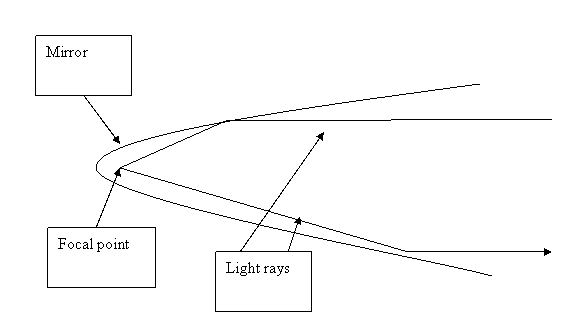
And a real image is formed in the plane of the focal point. I can put a piece of photographic film there or a digital light receptor and get a picture. Or I can look at it with a magnifying glass. If I do, it is called a Newtonian telescope, like the one taking shape over there.
Here is the light path for that telescope.
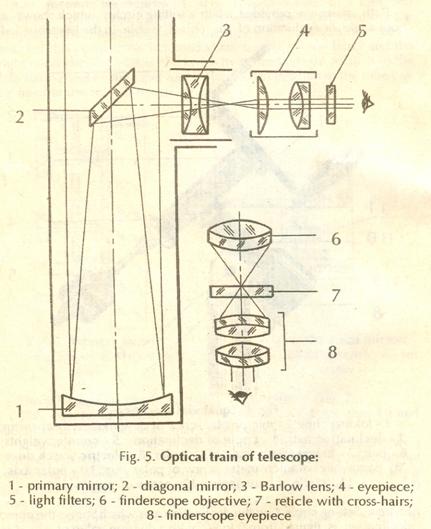
The primary mirror is obvious. The diagonal mirror is obviously in the way so that the center of the primary mirror is in shadow. Some telescopes have a hole there and reflect the light back down through the hole. With suitable corrective lenses that works quite well. You can see where the rays meet to form a real image. You can put your film or photocell there, or you can look at it with the eyepiece. Notice that the eyepiece is rather complex. Again, there are errors that need to be corrected.
Before we leave the reflecting telescopes there is one trick that so far as I know has never been tried. Here is on old portable record player. Sometimes it actually turns. This is a very dumb thing I am about to do. If I get electrocuted and ruin your day, let me apologize now while I can. OK. We’ve got the turntable going around. You can’t see it. You don’t even have to believe me. Just pretend. Next I put this dish on the turntable. Right now I am wishing this thing still ran on battery power, but it doesn’t so I am going to have to play dice with the devil and use wall current. Now I pour some water in the dish. As the dish turns, the water is thrown out to the sides by centrifugal force. The vibrations from the motor and drive chain make it slosh of course, but if the mechanics were perfect, the surface would have an excellent parabolic shape. Water isn’t much good as an optical reflector, but if we used mercury we could make a cheap and very large telescope. It would require suitable mirrors. Otherwise it could only look straight up. Now let’s see if I can get the water back without spilling it into the motor. There. Got it. Lets go on to something safer like lenses. Don’t try this at home. In fact don’t do it at all.
A lens functions because light entering glass at an angle is bent so that it is closer to being perpendicular to the glass.
Light ray
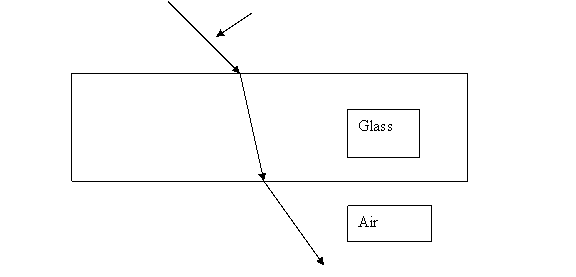
And when it comes out it resumes its original direction. The reason is that the light is slowed down by the glass. It’s not like Arthur dent learning to fly by throwing himself at the ground and missing. The light doesn’t go through because it misses everything. The light is an electromagnetic wave that interacts with the electrical bonds in the glass. Imagine a runner running over mattresses. The mattresses slow him down. A softer mattress slows him down more. The amount of slowing of the light is measured by something called the refractive index of the glass; that’s a number that lets you calculate the amount of bend if you know the angle the light is coming in from.
The reason it turns is because the right side of the wave hits and slows before the left if it is hitting glass on its right. There is the opposite effect when the wave leaves.
A suitable shaped piece of glass will act as a lens and make a real image where the rays meet.
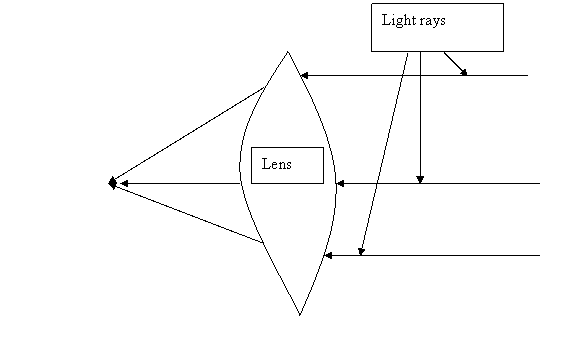
Again you can put film or a photoreceptor where the real image is, or you can look at it with an eyepiece. That is the essence of the telescope invented by Kepler and it is the way the conventional stealth telescope works. I use the objective lens to make a real image and then look at it with the monocle for an eyepiece. The mirror is just to make it stealthy.
The Galilean telescope handles the light differently.
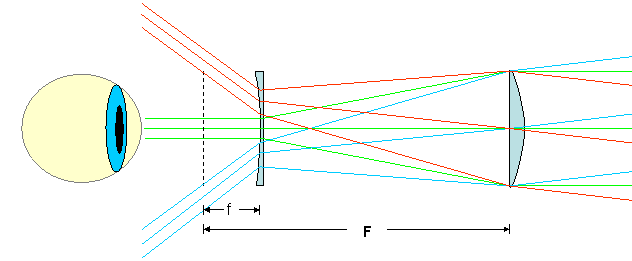
http://www.pacifier.com/~tpope/Galilean_Optics_Page.htm
Downloaded October 4, 2010.
It consists of a magnifying lens and then a minifying lens. The fact that the red and blue lines are diverging more after they leave the instrument than before they entered it makes the object appear closer and hence larger. The steampunk telescope will be closer to the Galilean than to the other two major classes of telescope.
The shape of the objective lens is crucial to either of these two classes of telescope. A spherical lens is cheap to make, but there is an error that a lens with spherical surfaces has called spherical aberration. Remember that the spherical mirror was not what you wanted for a telescope. The right shape for practical purposes was a parabola. Similarly, as it turns out, an objective lens needs to have a parabolic surface. A spherical surface is all right for the monocle because it is so close to your eye that the light rays do not have much time to get out of place before the eyes own optical properties take over. But down the long tube of a telescope it makes a significant difference.
The objective of the Galilean telescope there has a parabolic surface. That means it was a ridiculously expensive thing to make, but obviously the Italians who built it were in love with the idea of making it just right. It’s better than Galileo’s was. Not only is the objective lens better, but it is made of brass. Galileo’s was made of cardboard, just like the one I had as a child. Neither that telescope nor Galileo’s could resolve the rings of Saturn. (The Celestial Message, John L. Heilbron NATURE vol. 467 no. 7314 September 23, 2010 page 398.) Through Galileo’s they just looked like the planet had ears. You could make them out as rings through this one when it was new, if memory serves, but after thirty years of experiment and other abuse, she ain’t what she used to be.
There is also something called chromatic aberration. Remember our runner. Not only does a soft mattress slow the runner more, but a heavier runner is slowed more than a light one who only slightly dents the surface.
Blue light, toward the x-ray end of the visible spectrum, is more energetic than red light, toward the radio wave end. And as it turns out, blue light is more steeply bent during refraction than is red light. This is seen as a rainbow effect. Again, this is not much of a problem for a monocle, the colors not having time to separate much, but with a telescope they can make viewing a colorful experience.
Here is a diagram from Wikipedia.
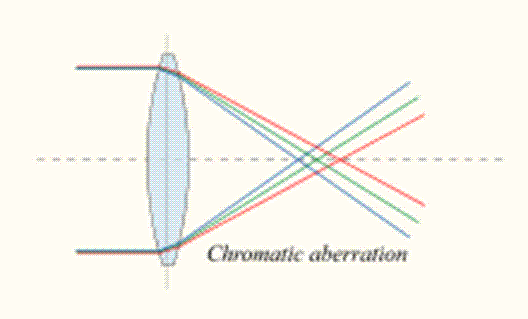
![]()
Chromatic aberration of a single lens causes different wavelengths of light to have differing focal lengths
http://en.wikipedia.org/wiki/Chromatic_aberration
Downloaded October 4, 2010.
The way you correct for it is to have a positive lens using a kind of glass that doesn’t spread the light out much followed by a weaker negative lens using a kind of glass that spreads it a lot. The result is a positive lens with a lot less chromatic aberration. This is a fairly simple example from the Russian telescope. A good camera lens, like the one in that camera there, will have several elements to correct for kinds of aberration and approximate a flat focal plane.
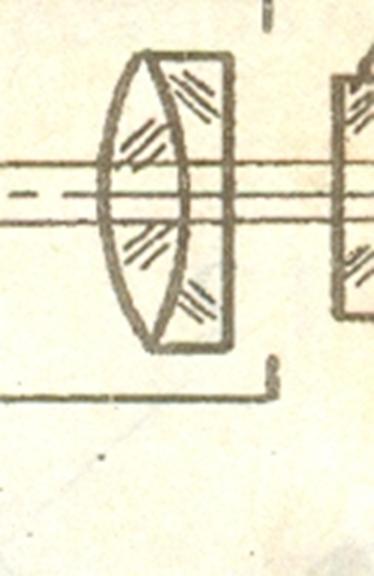
Let’s see how they are doing with putting the telescope together. Good. All right, this would be a nice telescope to have for your back yard for clear nights and assuming there is no city around with a lot of night glow. There is one remarkable thing about this telescope. Any guesses?
The mount of the telescope is designed so that the axis points toward the north celestial pole, approximately the North Star. Then a clock can drive it so that it stays in fixed alignment with the sky while the earth rotates beneath it. Look at how high this axis can air. It goes up to 30 degrees off the vertical. That means you could use it almost up to the arctic circle. I suppose they have a lot of time for star gazing in northern Siberia.
So far it’s like a fairy tale. The image is magnified and it reaches the eye and they all gazed happily ever after. In order to improve things we shall have to look at the eye itself.
Here is a diagram of it.

(An Eye to Treating Blindness, Elena Ezhkova and Elaine Fuchs NATURE vol. 466 no. 7306 July 29, 2010 page 567)
The real work of focusing the eye is done not by the lens nor the cornea, tan in this picture, nor even in the corneal epithelium. It is done by a thin layer of tear that wets the corneal epithelium. From then on, except when it is the lens, the light is essentially traveling through water. And water is a very strong spreader outer of colors. Furthermore, the cornea does not have a hard structure, as the lens does. It keeps it shape because of the pressure of the aqueous humor behind it, blue in the picture. So the leading refractive surface is roughly spherical. It’s not even a perfect sphere. The weight of the eyelids give it a little more curvature along the horizontal axis than the vertical axis. So a normal eye starts out its work on the light by introducing spherical aberration, chromatic aberration and astigmatism.
That tear film has another function. The front surface of the cornea is covered by the epithelium, which is a transparent layer one cell deep. It has no circulation, but it must survive. Oxygen is not a problem, since it is exposed directly to air. But nutrition is a problem. It has no fat stores, so it has to get its nutrition from the tears. So tears contain just a little sugar. They taste sweet.
The cells of the epithelium emerge from the limbus, which is red in the picture, and migrate over the surface of the cornea. They turn over every few hours. You can kill them by looking in bright sunlight for too long. This is called snow blindness, and it hurts. It lasts a few hours. Remember to wear your dark glasses to protect you from the ultraviolet. Chorine will kill the cells and give you the same thing, discomfort and blurred vision.
Or if you are foolish enough to make a fashion statement by filling your steam punk goggles with water, the fresh water will dilute the tears so there is not enough sugar, and the epithelium will die. Usually it will grow back just fine. But sometimes it doesn’t. Here’s what it looks like when the epithelium does not replace itself.
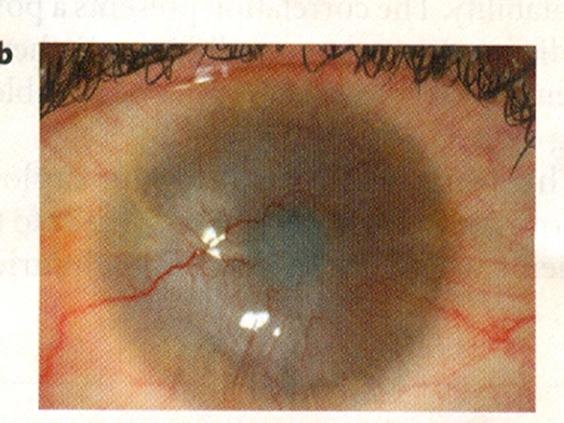
(An Eye to Treating Blindness, Elena Ezhkova and Elaine Fuchs NATURE vol. 466 no. 7306 July 29, 2010 page 567)
As you can see it is blurry and there are blood vessels running through to keep the abnormal tissue alive. This time there was a happy ending. They managed to transplant some stem cells from the limbus of the other eye, and this eye recovered.
If you could stand inside an eye and look at the image falling on the retina, it would show visible lens errors. A printed page would be an array of rainbows. Many years ago I was doing some optical experiments. I went to a friendly slaughterhouse and begged, and they were kind enough to give me the eye out of a cow. I don’t know if this is still possible. Somehow you never seem to get around to thanking people properly who help you the most.
I took the eye home and looked at it. The pupil was not round. It was oblong with a horizontal orientation. You can figure out why. Cat’s eyes in bright light are vertical slits. That lets it resolve vertical lines and vertical components of lines better. They are what give the eye information about distance. Gauging distance, particularly at close range, is important for a predator like a cat. It’s no use sneaking up on a mouse only to miss it at the last instant.
But for a cow, the important thing is to pick up a predator on the horizon. The sky is no threat – birds don’t get that big – and the ground where the grass is holds still and can be studied at leisure. But if there is a predator coming, the cow needs to see it far away. It is no use gauging the predators distance exquisitely well while your throat is being torn out. You need to take evasive action long before that. So the eye is structured to take less light in from the sky and the ground but to give a bright, wide field of view where the danger is.
I cut the eye in half, front and back. Then I sewed the front half of the eye onto a microscope slide and shined a slit of white light into the front. Then I held a white screen behind it so as to see what the real image on the retina looked like. Actually it was pretty good. There was some chromatic aberration – you could see rainbows – but not as much as you would expect, knowing how much an air-water interface breaks the light up.
The secret came out when I took the lens out and shined white light into it. What came out was white light. When I broke the lens, the light came out in white speckles. Having spent so much time working with murky rainbows, I thought the points of pure white looked beautiful. So how does that correct the error that the cornea introduces?
Look back at the eye again. Imagine taking the lens out and replacing it with air. The convex air lens inside water is like a concave water lens inside air. It is a negative lens with a lot of light dispersal. So our imaginary eye with an air lens can hardly focus at all. Usually the lens does not have much focusing power because it is effectively sunk in water; the difference between the refractive index of the lens and water is less than the difference between the refractive index of the lens and air. So the air lens is a negative and strong.
Now take our imaginary eye with an air lens and slip the normal lens back in place leaving a tiny air gap. Now the lens is doing most of the work of focusing and the chromatic aberration is greatly reduced. So the anatomy of the eye turns it into a pretty good achromatic lens. I wouldn’t be surprised to learn that it corrects for some of the spherical aberration as well.
For the astigmatism, the eye has another optical trick. In the back of the eye, not included in the picture, is a pit called the fovea. Color sensing cells are there in great number. It is the area where visual acuity is sharpest. The fact that it is a pit means that more cells can sit in a given tiny area as seen from the lens. It also means that things that are focusing at different planes can be evaluated all at once.
A hawk has a very deep foveal pit. Imagine the focusing problem that falcon has as it sweeps down on its prey. (The one I saw was actually sweeping up.) It comes in at about 200 miles per hour. At fifty yards it must see the quarry well enough to predict its flight path. A half second later it must strike at two inches distance. I can’t change focus that fast. If I ever have to do a lot of copying of things from a blackboard, I am going to take along some half height reading glasses. They ought to speed things up.
The residual lens errors of the eye are cleaned up by the computing power of the retina. Were I ever to use the word “miraculous” it would be to describe the way the retina takes this imperfect image of the world and cleans it up.
The challenge is to take that computing power and harness it. What we do is to take our goggles and flood them with water. Yes, I know this isn’t great for the eye, but nothing is too good for my heroes. We put the goggles on. The tear film of the cornea now has no refracting power. The front of the goggles is flat ideally. It’s hard to find flat goggles these days, but it’s pretty flat. So optically that eye cannot function except for the very blurry image it gets because of the pinhole effect of the iris. There is no real image in there at all.
That situation is easily remedied. We simply pick up a good camera lens. It is color corrected, has no astigmatism and negligible spherical aberration. It also has a flat focal plane. We use this sophisticated lens to put the real image on the retina. (And this I do.)
Now for the first time ever, the retina gets a good image to work with. The image is not perfect of course. All those corrections the eyes own lens was making are now errors. But the real image is better than anything nature can provide.
The retina does not get confused. It responds immediately by taking the computing power that it was using to correct lens errors and makes the colors truer, the edges sharper, subtle shading difference more apparent, and in general shows a brighter, richer visual world.
Add a mirror, and the device becomes stealthy.
Now in the real world, if you sit down at a sidewalk café and fill your goggles with water and put them on, your mark is likely to come over and say, “What are you doing?” “Are you all right?” “Can I help you?” or a number of other things a spy doesn’t want to hear. But in the world of steampunk, the goggles are expected, so he should ignore you.
Again, this isn’t something you want to try. But for fictional purposes it would work. (Stunned, repelled and generally embarrassing silence, I suppose.)
There have been 6,469 visitors counted so far.